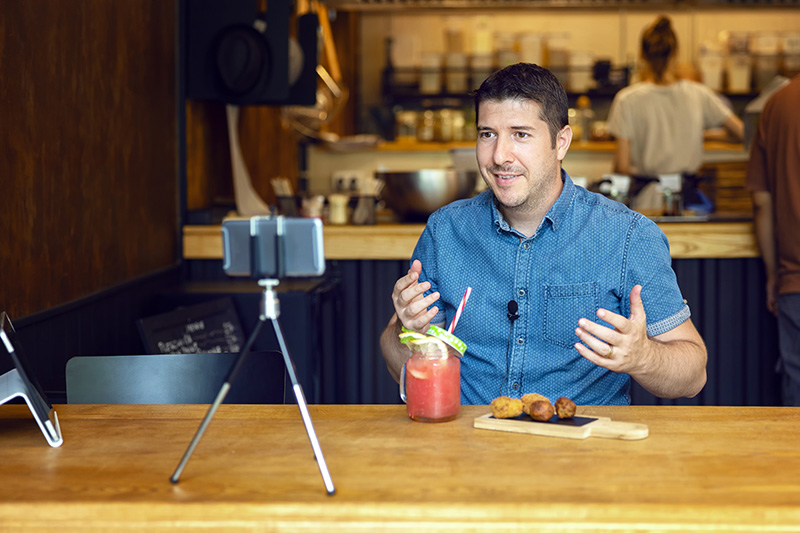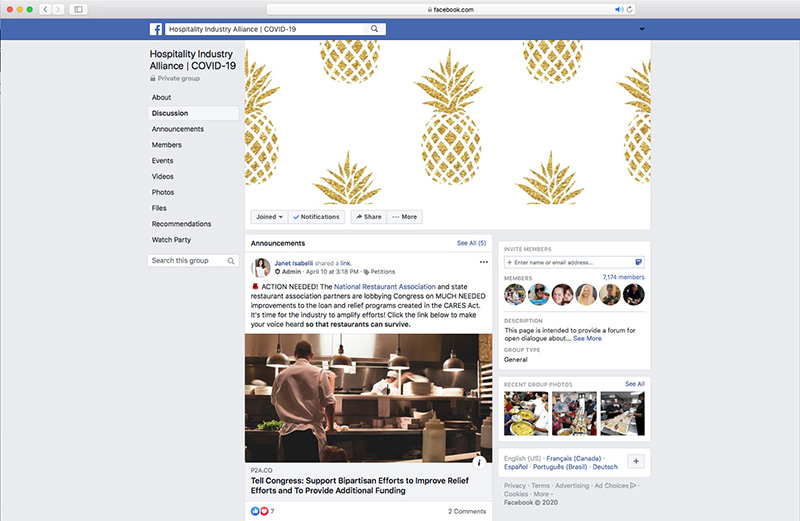A VIRTUAL LIFELINE
Social media should drive your post-pandemic offense
► For all the shortcomings of social media – foreign interference, data breaches and channels to sow misinformation – the networks that connect the world in real time established themselves as indispensable tools during the coronavirus pandemic.
The COVID-19 crisis underscored social media’s value across all sectors, especially in the hospitality industry, as it became a lifeline restaurants leaned on for survival. Operators used social media to stay in contact with their followers by sharing delivery information, recipes, cooking classes, cocktail demos, wine seminars and charitable efforts.
As states begin lifting stay-in-place mandates and operations start to reopen, the industry will need to rely on social media to connect and rebuild its rapport with customers.
“Social media, at its best, is about meaningful connections and trust,” says Edna Morris, a senior adviser for financial advisory firm PJ Solomon and CEO/owner of CityRange. “Trust will be more important than ever as cautious consumers decide where, when and how to gather and dine.”
Turning experiences into opportunity, such as knowing what to do and avoid, is critical for rebuilding that trust as well as preparing for future shutdowns, a possibility until a vaccine for coronavirus is available.
DO Join Groups
Beth Shepard, who heads a literary and spokesperson agency in western Massachusetts, proved Facebook groups can be effective. She launched Kitchen Quarantine on March 13 and amassed 6,900 members, including chefs, food media and home cooks, who posted daily. It encouraged members to post photos of their meals that evolved into requests for recipes.
DO Customize Hashtags
Are they in or are they out? Hashtags during a pandemic or a promotion are in. Teriyaki Madness, a fast-casual chain with locations nationwide, used the hashtag #thegreatamericantakeout as part of a nationwide effort to increase takeout orders, which earned 24,000 mentions on Instagram during the first Takeout Tuesday. Business significantly increased, according to Jodi Boyce, a Teriyaki Madness executive. Customized hashtags, which should be attention-grabbing, can take on a life of their own but have to be included in posts regularly with relevant information. But don’t overdo it; too many would be spam.
DO Master Social Media Tools
The ability to post live on Facebook, Twitter or Instagram has been a game-changer. Chefs created their own videos using iPhone and Android platform devices perched on tripods that can be inexpensively purchased online. They used self-made videos to connect daily with customers to share their daily routine, restaurant promotions, menu updates and cooking lessons. You can do the same.
DO Spread the Love
Share posts that your diners tag you in and tap the thumbs-up icon on a Facebook comment or the heart on Instagram or Twitter. It sends the message that you have acknowledged a customer, which is the digital equivalent of stopping by a table and saying hello.
DO Work Your Stories
Posting Instagram stories (tap the + sign) and Facebook (tap Your Story) allows you to promote limited-time dishes since stories disappear after 24 hours.
DON’T Forget to Tag
Tagging on Facebook and Instagram creates an instantaneous sharing mechanism that should continue post-pandemic. It’s also a way to give credit to others who are trying to build community and loyalty. Tag those with large followings but don’t forget individuals on Instagram who aren’t “verified” for their massive audience. They have value, too.
DON’T Keep Recipes to Yourself
Because recipes can require a lot of space and characters, posting them on social media hasn’t been considered a best practice – until now. Users aren’t likely to return to a post that may get buried in their newsfeed, so include the recipe with a photo. On Twitter, provide a link to your website or even a shortened URL to a rudimentary Google doc.
DON’T Let Your Memory Slide
Time has a way of shortening memory. When you return to your new normal, don’t allow connecting with customers to fall to the bottom of your to-do list. When staff return, get their feedback on how they stayed in touch using social media to glean ways to improve efforts.
A simple Facebook group united an industry in the worst of times
By Janet Isabelli
 There was an unusual chill in the Chicago air on the morning of Friday, March 13. A few days earlier, the International Housewares Show canceled its annual event, which normally draws 56,000 attendees. It proved to be a warning sign as similar scenarios played out across the entire country. No James Beard Foundation awards gala and no National Restaurant Association Show sent a clear message to the restaurant industry: COVID-19 was launching an attack, not only on our country but our entire economy as well.
There was an unusual chill in the Chicago air on the morning of Friday, March 13. A few days earlier, the International Housewares Show canceled its annual event, which normally draws 56,000 attendees. It proved to be a warning sign as similar scenarios played out across the entire country. No James Beard Foundation awards gala and no National Restaurant Association Show sent a clear message to the restaurant industry: COVID-19 was launching an attack, not only on our country but our entire economy as well.
I woke up that Friday – appropriately enough, Friday the 13th – knowing in the pit of my stomach that our lives were about to forever change. I decided, in that moment, I wouldn’t go down without fighting for the industry that has been so good to me for more than two decades.
I had a simple idea: Quickly launch an informative and supportive digital space that would allow others to share timely news and updates, from coast to coast, that could be of value to people in the restaurant industry. So I popped open my laptop and, within minutes, created a private Facebook group called Hospitality Industry Alliance | COVID-19, inviting every relevant person I knew. Within a week, we had amassed over 5,000 members; today, the group has more than 7,000 hospitality owners and workers, industry-adjacent marketers, human resource professionals, financial and legal whizzes and journalists nationwide.
 Our group has become an around-the-clock forum for information-sharing, posting questions, brainstorming, encouraging solidarity and directing calls to state and federal representatives. They have asked questions and raised pertinent issues that have broadened our collective knowledge of both direct and indirect advocacy points related to the COVID-19 crisis (topics such as business interruption insurance, taxes and employee relief programs) and motivated me to think strategically about how we will all reemerge on the other side of this crisis. The Hospitality Industry Alliance has generated near immediate responses to numerous topics, from filing for unemployment and navigating the CARES Act to best practices for delivery/carryout and questions specific to individual city and state regulations. It has also become a place for media to connect with sources and share their work.
Our group has become an around-the-clock forum for information-sharing, posting questions, brainstorming, encouraging solidarity and directing calls to state and federal representatives. They have asked questions and raised pertinent issues that have broadened our collective knowledge of both direct and indirect advocacy points related to the COVID-19 crisis (topics such as business interruption insurance, taxes and employee relief programs) and motivated me to think strategically about how we will all reemerge on the other side of this crisis. The Hospitality Industry Alliance has generated near immediate responses to numerous topics, from filing for unemployment and navigating the CARES Act to best practices for delivery/carryout and questions specific to individual city and state regulations. It has also become a place for media to connect with sources and share their work.
It’s more evidence that restaurants are the heartbeat of America – and that the industry will surely thrive again. Times of necessity breed innovation, and as they return, restaurants will have a better understanding of what works for their business as it relates to delivery; the dissemination of information (perhaps via new easier-to-navigate websites), modified dining room floor plans, comprehensive marketing strategies and stronger teams. A special magic lies in uniting others over mutual passions.
Above all, the Hospitality Industry Alliance has taught me how truly remarkable the human spirit can be. It’s heartening to know that in times of crisis, there is an indomitable willpower at this industry’s collective core. It perfectly illustrates the meaning of living hospitably, whether that involves someone lending an ear, tackling a new advocacy point (here’s looking at the farmers), providing a few free meals (sometimes thousands of them), or simply checking in. Despite the uncertainty the industry at large faces, its members choose to be good, giving citizens hope in the face of fear.
READY, SHOOT, POST
When chefs and restaurateurs are following stay-at-home orders like everyone else, it makes sense to connect with fans and customers on social media – just like megawatt chefs Daniel Boulud, Rick Bayless and Michael Symon who posted photos and videos of cooking from their home kitchens. Those who form and tighten bonds with customers now will be uniquely positioned for success because they’ve continued to engage – and expand – their fan base.
Post daily on all channels but specifically where your audience is active, whether it’s Facebook, Instagram or Twitter. It can be a video of a simmering dish, a photo of a meal or as simple as a thought for the day.
- Offer recipes with photos
- Conduct a simple cooking class or demonstrate a technique
- Ask for what followers want to learn or see
- Offer tips or a video on creating cocktails
- Discuss food and wine pairings

